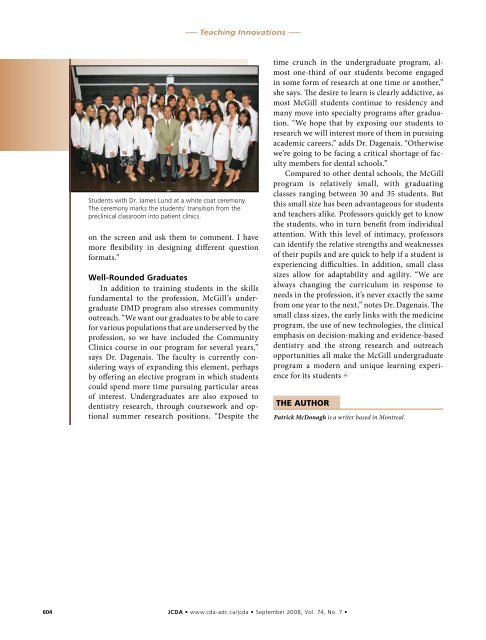JCDA - Canadian Dental Association
JCDA - Canadian Dental Association
JCDA - Canadian Dental Association
You also want an ePaper? Increase the reach of your titles
YUMPU automatically turns print PDFs into web optimized ePapers that Google loves.
––– Teaching Innovations –––<br />
Students with Dr. James Lund at a white coat ceremony.<br />
The ceremony marks the students’ transition from the<br />
preclinical classroom into patient clinics.<br />
on the screen and ask them to comment. I have<br />
more flexibility in designing different question<br />
formats.”<br />
Well-Rounded Graduates<br />
In addition to training students in the skills<br />
fundamental to the profession, McGill’s undergraduate<br />
DMD program also stresses community<br />
outreach. “We want our graduates to be able to care<br />
for various populations that are underserved by the<br />
profession, so we have included the Community<br />
Clinics course in our program for several years,”<br />
says Dr. Dagenais. The faculty is currently considering<br />
ways of expanding this element, perhaps<br />
by offering an elective program in which students<br />
could spend more time pursuing particular areas<br />
of interest. Undergraduates are also exposed to<br />
dentistry research, through coursework and optional<br />
summer research positions. “Despite the<br />
604 <strong>JCDA</strong> • www.cda-adc.ca/jcda • September 2008, Vol. 74, No. 7 •<br />
time crunch in the undergraduate program, almost<br />
one-third of our students become engaged<br />
in some form of research at one time or another,”<br />
she says. The desire to learn is clearly addictive, as<br />
most McGill students continue to residency and<br />
many move into specialty programs after graduation.<br />
“We hope that by exposing our students to<br />
research we will interest more of them in pursuing<br />
academic careers,” adds Dr. Dagenais. “Otherwise<br />
we’re going to be facing a critical shortage of faculty<br />
members for dental schools.”<br />
Compared to other dental schools, the McGill<br />
program is relatively small, with graduating<br />
classes ranging between 30 and 35 students. But<br />
this small size has been advantageous for students<br />
and teachers alike. Professors quickly get to know<br />
the students, who in turn benefit from individual<br />
attention. With this level of intimacy, professors<br />
can identify the relative strengths and weaknesses<br />
of their pupils and are quick to help if a student is<br />
experiencing difficulties. In addition, small class<br />
sizes allow for adaptability and agility. “We are<br />
always changing the curriculum in response to<br />
needs in the profession, it’s never exactly the same<br />
from one year to the next,” notes Dr. Dagenais. The<br />
small class sizes, the early links with the medicine<br />
program, the use of new technologies, the clinical<br />
emphasis on decision-making and evidence-based<br />
dentistry and the strong research and outreach<br />
opportunities all make the McGill undergraduate<br />
program a modern and unique learning experience<br />
for its students a<br />
THE AUTHOR<br />
Patrick McDonagh is a writer based in Montreal.
















